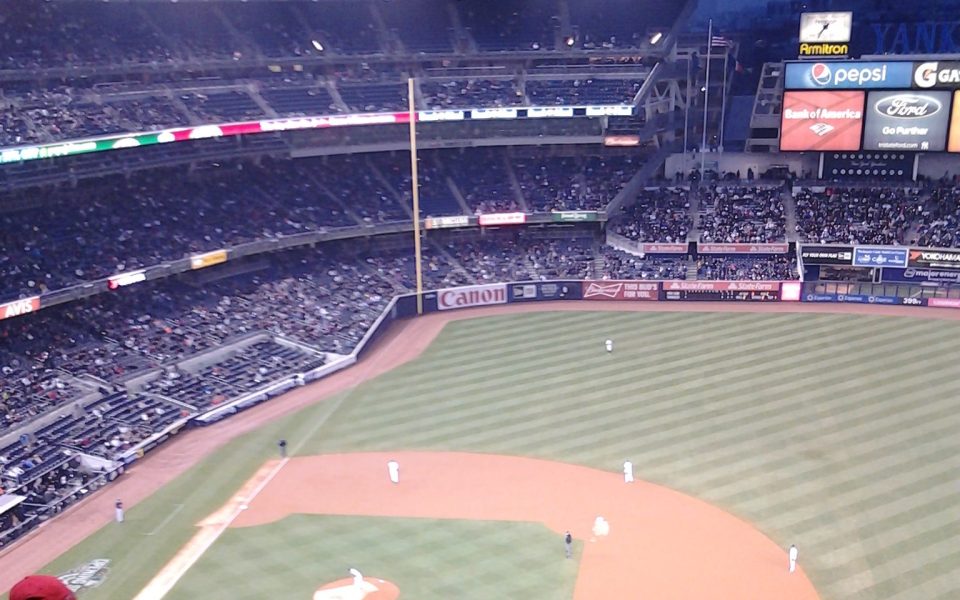It was a game I thought may not happen. Then it was a game I thought may never end.
I’d been checking the weather in New York for a week before I was to fly up. Friday, April 10 seemed bleak — the chance of rain, even storms for a Friday Red Sox-Yankees game at the beginning of the season, seemed unavoidable.
But New York springs tend towards unpredictability.
As my friend Zach and I arrived at New Yankee Stadium before the game, the sun burst through light clouds, dispelling any fears of a rain check and a refund. Pinstripes had filled the 4 Train heading up to 161st Street in the Bronx, as well as some brave souls decked out in BoSox regalia, spitting slurs in incoherent Boston-ese.
New Yankee Stadium struck me almost as strongly as when I saw the Parthenon. The massive scale of the place overwhelmed me. It was the House that George Built, across the street from the House that Ruth Built, no longer extant but in memory, on film and in legend. The aptly named, 8-acre Heritage Field sits in its place.
Another bit Yankees heritage passed last year. Derek Jeter — Mr. November, the newest gentleman of baseball — retired in 2014. Along with his retirement, another era of the Yankees’ history ends: the Greensboro era.
For years, Greensboro’s minor-league teams produced timeless talent through War Memorial Stadium for the Bronx Bombers. Jeter — along with Don Mattingly, Mariano Rivera, Andy Pettitte and Jorge Posada — played for the Greensboro Hornets, the team which begat the Bats, then the Grasshoppers. Robinson Canó, the former Yankees second baseman and the final great Bats recruit, now plays for Seattle.
The Hornets and the Core Four have all vaulted Yankee lore as surely as Murderers’ Row and the old stadium.
But history is made every day.
While he didn’t play for the Hornets, one man remains from the Greensboro era, and Yankees fans revere him as much as many despise him: Alex Rodriguez.
Each of the five times the hometown anti-hero stepped up to the plate, accompanied by Journey’s “Don’t Stop Believin’,” the constant low drone of the crowd — muted due to our seats in paradise — became an enthusiastic roar. Rodriguez played well; he started the Yankees rally with an RBI single in the bottom of the 6th.
The stadium thundered with appreciation.
Though controversy engulfs Rodriguez, there’s no one on the team the Yankees’ faithful adore more. He’s something of a god to them.
If A-Rod was the home-team hero, it’s very clear who the devil on the Red Sox squad was: David Ortiz.
Damn if the Yankees do not hate that man. From his first at-bat until his eighth and final in the top of the 18th, the crowd booed his name with the intensity that they cheered Rodriguez. One Boston fan a few rows ahead of us, sporting an Ortiz jersey, was the sole person in our section against the tide, screaming, “Go, Big Papi!” at each plate appearance.
But there’s good reason for the hate.
Though Ortiz only hit .200, his two blasts came at crucial moments, including a soaring homer in the 16th. Big Papi vindicated that lone Sox fan, who stood and took a bow from his seat in Section 415 as someone screamed, “Go back to Boston!”
At that point, David Ortiz was my favorite human being.
It was 12:45 a.m.; Zach and I had begun to tire. Our allegiances shifted fickly. We rooted for offense; every batter was a chance for the grueling game to end.
The mild evening had turned into a frigid night. Up in the nosebleeds, ice formed in the skinniest puddles, and I’d begun to lose feeling in my museum-racked feet. The initial crowd of 41,292 had dwindled until the stadium was at about 10-percent capacity. Red jackets stuck out like acne amongst the blue bleacher seats.
But then, Yankee first-baseman Mark Teixeira smacked a floater into the stands. Despite the thinner crowd, the stadium exploded into a deafening roar.
We became a bit despondent.
“Now I hope the Yankees win so we can go home,” Zach said.
We figured we would simply live in Yankee Stadium, surviving off kraut dogs and overpriced Coors Light.
Finally, this game did end — spectacularly so.
After Mookie Betts, a recent addition to the Sox lineup, batted in a run off a sacrifice fly in the top of the 19th, the Sox sealed the deal with an acrobatic 6-4-3 double play — Bogaerts to ’Droia to Nap — a clinic on how to perfectly execute the defensive stop, a last burst after a game of short-lived successes and strenuous lulls.
It was 2:13 a.m. It was the longest game in Red Sox history. And it was the longest game yet played in New Yankee Stadium.
History is made every day.
Join the First Amendment Society, a membership that goes directly to funding TCB‘s newsroom.
We believe that reporting can save the world.
The TCB First Amendment Society recognizes the vital role of a free, unfettered press with a bundling of local experiences designed to build community, and unique engagements with our newsroom that will help you understand, and shape, local journalism’s critical role in uplifting the people in our cities.
All revenue goes directly into the newsroom as reporters’ salaries and freelance commissions.




Leave a Reply